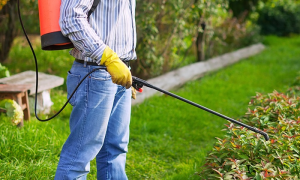Pest Control Bridgewater NJ includes a range of physical, biological, and chemical tactics. The best strategy depends on the type and severity of a pest problem.
Clutter provides places for pests to breed and hide, so be sure to remove stacks of newspapers or magazines. Also, close gaps around doors and windows. Repair leaking pipes and keep gutters clear of debris.

The goal of preventive pest control is to keep infestations from occurring in the first place. This involves regular inspections and maintenance and taking steps to prevent food, water, shelter and/or hiding places from being available to the pests. Often, this will involve sealing cracks, installing screens and barriers, and maintaining the structural integrity of buildings. This approach can also be enhanced with a strong program of sanitation, in which employees are educated to properly handle their work materials to minimize the potential for bringing in pests from outside.
Structural prevention involves designing and maintaining the environment so that pests cannot access the resources they need to survive and grow. This includes establishing regular cleaning routines and keeping trash and waste materials tightly secured, such as using clean tote bins for garbage collection. It may also involve improving building and food storage systems to make them more resistant to pests, such as arranging shelving and storing materials to prevent pests from crawling or slithering on or under them.
Natural enemies can help control pest populations through predation, parasitism and herbivory. This can be accomplished either by introducing natural enemies from other areas or through classical biological control, in which natural enemies are augmented through laboratory breeding and then released into the field in small batches, rather than in one large release.
Altering the environment by modifying the amount of food or water, temperature, light or shade can also be effective in controlling pests. However, these techniques usually are not applicable to indoor environments where the environment cannot be altered.
Pesticides can be used effectively in prevention and control. These substances can be sprayed, dripped or baited into pests’ habitats. Careful application and reading the pesticide label’s instructions will reduce the risk of exposure to people and pets.
Eradication is a rare goal in outdoor pest situations, although it is sometimes attempted when an introduced pest becomes established and poses an unacceptable threat. In enclosed environments, such as residential and commercial structures; offices; health, food processing and distribution facilities; and museums and art galleries, eradication is not practical, but prevention and suppression are often goals.
Suppression
Suppression methods limit pest activity and prevent population growth by quickly controlling existing pest infestations. The actions may be chemical, mechanical or cultural. Frequent monitoring will enable the selection of suppression tactics that minimize off-target damage.
Insect and vertebrate pests thrive in habitats that are hospitable to them, such as those provided by crops or landscape plants. If they are allowed to build up, the pests will damage or destroy their host, resulting in economic or environmental harm. Therefore, it is important to suppress the pests once they have reached damaging levels.
To reduce insect populations, the most basic method is to eliminate the conditions that make them a threat. For example, caulking cracks and holes in the home is an effective way to stop pest entry. Similarly, cleaning and frequently clearing out areas where pests hide (attics, basements, under sinks) will make them easier to find and target.
Mechanical controls include picking large or brightly colored foliage feeders by hand, shaking plants to dislodge adults and using fly swatters. A good tillage or cultivation system exposes many soil insects to desiccation and predation, while a spray of water can quickly knock down an aphid or mite colony. The use of nematodes that kill harmful soil grubs is another useful form of biological control.
The natural enemies of pests are predators, parasites, disease organisms and herbivores that maintain a balance with the pests in the natural environment. In conservation or augmentation biological control, these natural enemies are conserved and then released in sufficient numbers to significantly reduce the pests. However, a time lag often exists between the increase in the number of pests and the increase in the number of their natural enemies.
Chemical control of weeds and other pests includes the use of herbicides, fungicides and insecticides that act as poisons to kill them. This method is usually employed when prevention or eradication is impossible or impractical. Chemicals used in suppression must be selected with care to minimize off-target damage.
Eradication
Eradication is the ultimate goal of pest control. It’s not an easy task and it usually involves controlling a problem at the local, national or global level. An eradication program can take decades to complete and requires substantial financial resources. In addition, there are social and environmental factors that can impede an eradication effort. The term eradication comes from the Latin word eradicare, meaning to pull up by the roots. The word has also been interpreted as “to destroy completely” or to remove from sight or existence.
Eradication may include killing the pests, removing their eggs or larvae, or destroying the habitat that supports them. It can also involve releasing the natural enemies of the pests in the target area to manage the population. This can help to reduce the need for toxic chemicals. Biological methods are one of the oldest forms of pest control.
Parasites, predators and pathogens are natural enemies of pests. Parasites are organisms that live on or in other living organisms for their entire lives and consume the host for food. Predators are natural organisms that kill or capture other animals and typically eat meat. Pathogens are microorganisms that cause disease in plants or animals.
Attempts to eradicate pests often involve introducing the predators, parasites or pathogens that are naturally present in the target area. This can be done by releasing the natural enemies into the area or encouraging their presence through changes to the environment. For example, a homeowner can encourage natural predators by planting flowers that attract them, or they can plant fruiting shrubs that will lure birds that are natural predators of insects.
Chemicals that kill or disrupt the function of a pest or its eggs are classified as pesticides. This class of chemicals includes herbicides, insecticides and fungicides. Some pesticides attract, repel or confuse pests. Others change the behavior of pests by changing their odor, stimulating them or inhibiting their reproduction.
Until the development of DDT and other synthetic chemicals, extermination was the primary method of pest control. This approach was often harsh and relied on the use of deadly chemicals, such as arsenic and strychnine. While this approach rarely eradicated the problem, it created a widespread public perception that pests were dangerous and should be treated with contempt.
Reduction
Pests can damage and spoil crops, food, clothing, wood structures, buildings, lawns, and other valuable possessions. They also can disrupt natural habitats and introduce disease organisms or parasites into new areas.
The best approach to pest control is prevention. Often, it is possible to keep pests from damaging property or causing health threats by adjusting the environment to make it less suitable for them. For example, removing food scraps from the home and keeping garbage in sealed containers will help reduce rodent populations. Regular maintenance on the house and grounds will prevent weed growth that provides food and shelter for insects. Changing the plantings around the house to those that are resistant to particular pests can minimize insect damage.
When pests do occur, it is important to evaluate the situation carefully before beginning management. A careful inspection will identify the pest, its impact, and the causes of the problem. This information will guide selection of control methods.
Integrated Pest Management (IPM) is a comprehensive approach to pest control that incorporates all available tools, including mechanical, cultural, biological, and chemical controls. IPM programs emphasize monitoring and scouting to determine the pest’s presence and population levels and to assess damage or injury. When a threshold for action is reached, treatment will be initiated using the appropriate control method.
There are a wide variety of pest control chemicals, each with its own advantages and disadvantages. Choosing the proper chemical depends on the situation and must be made with the greatest caution. Many modern pesticides are relatively harmless to humans and pets when used according to instructions on the label. Other pesticides are much more hazardous and should only be used when absolutely necessary.
A professional pest control company can save time, money, and peace of mind by ensuring that the environment is not a welcoming place for unwanted visitors. Routine pest control will minimize the potential for expensive repairs or replacements and preserve the value of your property. In addition, some pests carry harmful pathogens that can be dangerous to human health and may also cause allergic reactions in people.

